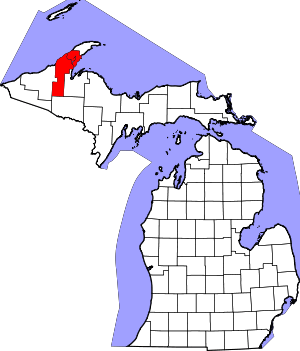Hancock, Michigan
Hancock is a city in Houghton County in the U.S. state of Michigan. It is located across the Keweenaw Waterway from the city of Houghton on the Keweenaw Peninsula. The population was 4,634 at the 2010 census. The city has been consistently ranked as the third-snowiest city in the United States by The Weather Channel.[6][7]
Hancock, Michigan | |
|---|---|
| City of Hancock | |
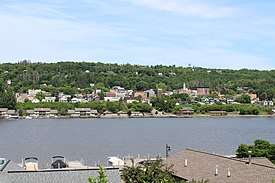 View from Houghton looking across the Keweenaw Waterway | |
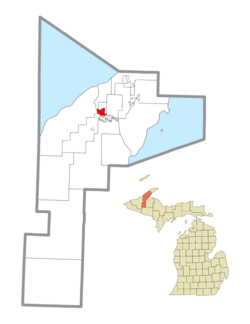 Location within Houghton County | |
 Hancock Location within the state of Michigan | |
| Coordinates: 47°07′49″N 88°35′47″W | |
| Country | United States |
| State | Michigan |
| County | Houghton |
| Founded | 1859 |
| Incorporated | 1863 (village) 1903 (city) |
| Government | |
| • Type | Council–manager |
| • City manager | Barry Givens |
| • Mayor | Paul LaBine |
| Area | |
| • Total | 2.57 sq mi (6.67 km2) |
| • Land | 2.57 sq mi (6.67 km2) |
| • Water | 0.00 sq mi (0.00 km2) |
| Elevation | 696 ft (212 m) |
| Population | |
| • Total | 4,634 |
| • Estimate (2019)[3] | 4,506 |
| • Density | 1,750.58/sq mi (675.92/km2) |
| Time zone | UTC-5 (EST (UTC-5)) |
| • Summer (DST) | UTC-4 (EDT (UTC-4)) |
| ZIP code(s) | 49930 |
| Area code(s) | 906 |
| FIPS code | 26-36300[4] |
| GNIS feature ID | 0627710[5] |
| Website | Official website |
History
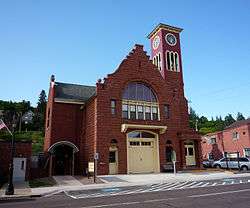
The story of Hancock began during the summers of 1847 and 1848, when a small-scale yet significant group of prospectors labouring on a rugged hillside (later to be named Quincy Hill) discovered a sequence of prehistoric Ojibwe copper mining pits, stretching out for 100 feet along the local amygdaloid lode. Upon inspecting a select one of the pits they realised that the Native Americans were able to take a considerable amount of copper in the form of small quantities through these small pits. The discovery on the Hicks property formed the basis upon which the Quincy Mining Company was created in October 1848, under a special charter granted by the legislature of the time.[8]
The earliest building in what is now the City of Hancock was a log cabin erected in 1846 on the site of the Ruggles Mining Claim, halfway up atop the hillside; it is no longer standing as the site has been taken up by the Houghton County Garage buildings.[9][10] It was owned by Christopher Columbus (C.C.) Douglass, who came to live there in 1852. The Quincy Mining Company founded Hancock in the year of 1859 after purchasing the land from Douglass and building an office and mine on the site.[11][12][13][14][15] The city was named after John Hancock, a signer of the Declaration of Independence.[16][10][17]
Hancock's first store was built by the Leopold brothers in 1858; the store also housed the first post office. Samuel W. Hill, an agent for the Quincy Mining Company, platted the Village of Hancock in 1859.[18][10][14][19] On 20 August 1860, Bishop Frederic Baraga and Reverend Edward Jacker selected lots nine and ten of block eight in the village for the purpose of constructing a church. It was on the northeast corner of what is now Quincy and Ravine Streets. The Quincy Mining Company donated this ground, but for a reason unclear the official paperwork didn't go through for this until 2 July 1875.[20]
In the earliest days of Hancock, the village had been within the borders of what is now the Portage Charter Township, however, on 1 April 1861, the area was set off and organized into a new township called Hancock Township.[14] The Portage Stamp Mill was also founded nearby at Portage Lake in 1861.[21] In the year 1860, the Keweenaw Waterway was dredged, widening the then-Portage River to allow more aqua transportation to Hancock, and neighbouring Houghton. However, the waterway was initially opened to ships in 1859.[22]
Also in 1859 was the debut of the Hancock Mine, which would later be called the Sumner Mine before being switched back to the Hancock Mine once more. The mine was situated on Quincy Hill near both Summit and Franklin Streets in an area that is now part of the modern-day Finlandia Campus.[23][24][12]
On 10 March 1863, the Village of Hancock was officially organized and the first officers were elected in the office of William Lapp, the justice of the peace and a pioneer lawyer of the time. Hervey Coke Parke was elected as the first village president. This is considered as the founding date of Hancock.[25][26][21][14]
M.J. McGurrin opened the first drug store in the village in 1865. There were also a few small grocery stores where James Artman sold handmade harnesses. The population of the town may have been about four hundred people in all, the majority of whom were miners who had occupied smaller houses near the vicinity of their workplace, the mines.[21]
On Sunday, 11 April 1869, Hancock is struck by the worst fire in the community's history when a stovepipe in a local saloon where the post office is now located had exploded and engulfed the building in flames. It soon spread across the village with the help of a strong west wind. The fire ended up destroying some 150 buildings, including every store in the village and almost all of the business places in general, the wooden bridges that had stretched across the ravines, and an additional 120 homes. At the time, Hancock had no fire department or fire equipment in the village, however, this short-lived fire had completely obliterated three-fourths of Hancock. It took two years to rebuild the village.[27][20][28][29][21][25][12][13] Famously, Mary Chase Perry Stratton, the founder of the Pewabic Pottery, survived the 1869 fire without injuries.[30]
On 1 March 1871, in response to the devastating fire of 1869, the Hancock Fire Department was officially organized. In an 1883 publication the fire chief, Archibald J. Scott, stated that the fire department had 2,500 ft of hose on hand and that the water supply was ample.[14][31]
In 1872 the Hancock and Calumet Railroad (H&C RR), as well as the Mineral Range Railroad (MRRR) began their operations. The Mineral Range Railroad provided passenger and freight service between Houghton, Hancock, Dollar Bay and Calumet.[12][32][33] The Mineral Range had their yards along Portage Lake near Tezcuco Street.[12] In 1877 Gustave Diemal, an immigrant from Germany as well as the 1870 Sheriff-elect of Keweenaw County, arrived in Hancock and opened the doors of his jewelry and watchmakers shop.[18][14]
In 1876, the Reverend Alfred Elieser Backman arrived in Hancock and served as the Copper Country's first pastor of the Evangelical Lutheran Church of Finland. He found a divided community of Finnish Lutherans in which some were faithful followers of the Church of Finland, and others Laestadian.[21][34][35] Backman later found the situation too unstable for his handling and was replaced by the Reverend Juho Kustaa Nikander who had arrived that same month in January 1885.[25][34] By the year 1889, four pastors from the Church of Finland were serving Finnish communities in the Upper Peninsula, among them was Reverend J.K. Nikander, along with Rev. Jacob Juhonpoika Hoikka (who had served as Nikander's co-pastor), Rev. Kaarlo L. Tolonen of Ishpeming, and Rev. Johan W. Eloheimo of Calumet. The four pastors met often and eventually founded the Suomi Synod on 25 March 1890, though they had conceived the idea as early as November 1889.[25][34][36][21][35]
Suomi College was founded in September 1896 by J.K. Nikander, and later, on 21 January 1900, Suomi College had completed their first building which is now affectionately called "Old Main" on Quincy Street. As many as two-thousand people traveled to Hancock to see the laying of the cornerstone.[12][25][34][37][14][38][35] Akin to a large handful of historic buildings in the city, it is made of Jacobsville Sandstone[12][13] and is built in the Richardsonian Romanesque style of architecture.[13] For eight years, Nikander, who had served as the College's first President, resided in Old Main.[25] Also in 1900, the Book Concern of Suomi College was established as the publishing house of the Finnish Evangelical Lutheran Church of America.[14]
In 1898, the Quincy Smelter was constructed in nearby-Ripley, Franklin Township, to serve the industrious Quincy Mine. The smelter was built on a site formerly held by the Pewabic Mining Company, which the Quincy had absorbed in 1891.[39] In 1893 both the Hancock and Calumet Railroad (H&C RR) and the Mineral Range Railroad (MRRR) were administered by the Duluth, South Shore and Atlantic Railroad (DSA).[12]
On Friday, 28 August 1896 the Finnish Evangelical Lutheran Church of Hancock was struck by lightning, which killed the assistant pastor and then-recently appointed Suomi College instructor Jooseppi Riippa after he had just finished dismissing 50 children because of the severe weather.[40][21][20][41][35]
The Houghton County Street Railway Company (later renamed in 1908 to the Houghton County Traction Company) also offered street car service from Houghton through Hancock to Calumet, Laurium, Mohawk, Hubbell, and Lake Linden, beginning in 1902.[12][42][43] In fall of 1902 the Kerredge Theatre was completed by William and Ray Kerredge in response to the wildly popular Calumet Theatre.[44][45] Hancock was officially incorporated as a city on 10 March 1903 and subsequently divided into four wards. The then-incumbent village president Archibald J. Scott was elected as the city's first mayor.[16][14][46][10]
After having broken ground for the construction process in August 1903, on 5 June 1904 the St. Joseph's Medical Center was dedicated in a public ceremony. Built with brick and local Jacobsville sandstone, the new complex was five-stories high and of the Renaissance style architecture. The entryway was completed at a cost of $78 000 plus $21 396 for necessary equipment.[47][14] In 1906, the Scott Hotel on East Quincy Street had been completed.[12][48][49] One year later, the Copper Country Limited line of both the Chicago, Milwaukee, St. Paul and Pacific Railroad and the Duluth, South Shore and Atlantic Railway, began its operations. The line went to Calumet in the north, running through Hancock, and connecting the Keweenaw to Chicago, Illinois, where it had begun.[50]

In 1906, the Scott Hotel, located adjacent to the previously-erected Kerredge Theater, was built and named after the prominent city businessman and mayor Archibald J. Scott. The Scott Hotel was constructed as a symbol of Hancock's size and importance.[45][51] In 1906, the Hancock Mine expanded its operations and sunk the No. 2 vertical shaft.[23] In 1913, Hancock's Scott Hotel was host to the aberrant high-profile kidnapping, shooting, and beating of Western Federation of Miners President Charles Moyer, and his bodyguard Charles Tanner, at the hands of members of the local Citizens' Alliance in the Keweenaw and Houghton County Sheriff's Department. This was in response to his pleas to Michigan Governor Woodbridge Ferris and US President Woodrow Wilson for proper investigations into the Italian Hall Disaster. The kidnapping, beating, and subsequent "deportation" to Chicago by officials of the area has cemented its place in local memory.[52][41][53][54][55][56]
Prior to World War I and around the time of the tempestuous Copper Country Strike of 1913–14, the population of the city had dropped from its all-time high of 8,981 to 7,527 as many families moved away with the heads of their households to seek a means of living in the factories of Lower Michigan and Wisconsin or in other copper mines in the state of Montana.[14]
Hancock received its second hospital in March 1917, a Finnish hospital called Suomalainen Sairaala. The hospital was also called the Hancock Bethany Hospital, and later known as Dr. Henry Holm's Hospital.[57][14] In 1917 the old First Congregational Church of Hancock, on the corner of Quincy and Tezcuco Streets, had burnt down. Following this unfortunate event in 1921, the new First Congregational Church of Hancock had been completed to replace the old one that had burned, though they had already begun services after breaking ground in 1919.[58][20]
Misfortune came to Hancock following the financial crash in 1929 as mines began to close for lack of a profitable market. Copper at the time sold for only five cents a pound.[14] The Quincy Mine closed in 1931, and neighbouring mines closed in the following year.[59][14] By 1934, one third of the families in Houghton County were seeking aid through the relief program set up. The Quincy Mine resumed its operations in 1937, but discontinued them in 1946, one week after Japan surrendered in 1945, ending World War II.[14]
By 1949 the facilities of St Joseph's Hospital were no longer adequate to meet the needs of the population, and through funds from the Hill-Burton Act and lavish contributions of hospital benefactors, the new St. Joseph's Hospital facility on Michigan Street was assembled. The new building was dedicated on 29 July 1951 by Bishop Thomas L. Noa of the Roman Catholic Diocese of Marquette. The first patients were moved into the new edifice on 27 August 1951.[47][14]
On Friday, 29 May 1959 the iconic and historic Kerredge Theater, the counterpart to The Calumet Theatre, burned to the ground.[14][23][45] Joint preparations with the neighbouring city of Houghton were undertaken and carried out in 1963 to install a sewage disposal plant to prevent the contamination of Portage Lake.[14]
During the United States Bicentennial in 1976, then-Finnish President Urho Kekkonen paid a visit to the Hancock area and entirely filled the Michigan Technological University ice arena in Houghton when he gave his official address to the local Finnish-American community of the region.[25][60][61] In the year 1990, a rundown former Catholic church on Quincy Street was renovated extensively with traditional Finnish architectural styles and it thus officially became the Finnish-American Heritage Center.[13][62]
Geography
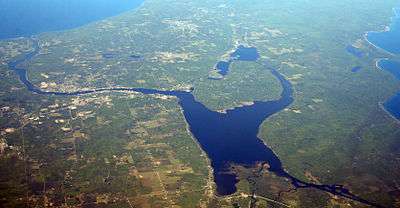
The City of Hancock is further north than Montreal in Quebec, Canada.[10] According to the United States Census Bureau, the city has a total area of 2.97 square miles (7.69 km2), of which 2.60 square miles (6.73 km2) is land and 0.37 square miles (0.96 km2) is water.[63] Hancock is connected to the city of Houghton by the iconic Portage Lake Lift Bridge, which crosses the dredged Keweenaw Waterway. The Keweenaw Waterway is the body of water which effectively slices the Keweenaw in two. Both Houghton and Hancock are situated on 500-foot bluffs similar to San Francisco, especially on the northern side upon which Hancock lies.[37]
The city is bounded on the south by the Portage Canal, parts of Quincy, Hancock and Franklin Townships; on the east by West Ripley; and on the north by Quincy and Hancock Townships. Houghton aside, other communities that directly share a border with the City of Hancock include Ripley, and Arcadian Location.[10]
Climate
Hancock has a humid continental climate, with typically long and snowy winters and much lake effect snow. Hancock has the distinction of being the third-snowiest city in the United States, the snowiest city in the Midwestern United States, and the snowiest city in the Eastern United States, with snowfall averaging 211.7 inches per year. The city is located along the lake effect snow-prone Keweenaw Peninsula. In the 1978–79 snow season, a whopping 390 inches of snow fell in Hancock. Accumulating snow has been known to fall as late as early June here.[6][7]
| Climate data for Hancock, Michigan (Houghton County Memorial Airport), 1981–2010 normals | |||||||||||||
|---|---|---|---|---|---|---|---|---|---|---|---|---|---|
| Month | Jan | Feb | Mar | Apr | May | Jun | Jul | Aug | Sep | Oct | Nov | Dec | Year |
| Record high °F (°C) | 50 (10) |
60 (16) |
79 (26) |
88 (31) |
95 (35) |
99 (37) |
102 (39) |
98 (37) |
95 (35) |
86 (30) |
71 (22) |
64 (18) |
102 (39) |
| Average high °F (°C) | 22.1 (−5.5) |
24.6 (−4.1) |
33.5 (0.8) |
46.9 (8.3) |
61.0 (16.1) |
70.2 (21.2) |
75.3 (24.1) |
73.9 (23.3) |
64.6 (18.1) |
51.2 (10.7) |
37.6 (3.1) |
26.2 (−3.2) |
49.0 (9.4) |
| Daily mean °F (°C) | 15.5 (−9.2) |
16.9 (−8.4) |
25.2 (−3.8) |
38.0 (3.3) |
50.2 (10.1) |
59.3 (15.2) |
64.8 (18.2) |
63.9 (17.7) |
55.4 (13.0) |
43.4 (6.3) |
31.4 (−0.3) |
20.2 (−6.6) |
40.5 (4.7) |
| Average low °F (°C) | 8.8 (−12.9) |
9.1 (−12.7) |
16.8 (−8.4) |
29.0 (−1.7) |
39.4 (4.1) |
48.4 (9.1) |
54.2 (12.3) |
54.0 (12.2) |
46.3 (7.9) |
35.6 (2.0) |
25.3 (−3.7) |
14.2 (−9.9) |
31.9 (−0.1) |
| Record low °F (°C) | −29 (−34) |
−30 (−34) |
−23 (−31) |
−4 (−20) |
19 (−7) |
28 (−2) |
32 (0) |
34 (1) |
24 (−4) |
12 (−11) |
−7 (−22) |
−19 (−28) |
−30 (−34) |
| Average precipitation inches (mm) | 2.58 (66) |
1.37 (35) |
1.56 (40) |
1.84 (47) |
2.50 (64) |
2.58 (66) |
2.49 (63) |
2.41 (61) |
3.45 (88) |
2.99 (76) |
2.13 (54) |
1.89 (48) |
27.79 (706) |
| Average snowfall inches (cm) | 68.8 (175) |
30.9 (78) |
19.2 (49) |
7.8 (20) |
1.0 (2.5) |
0.0 (0.0) |
0.0 (0.0) |
0.0 (0.0) |
0.2 (0.51) |
4.7 (12) |
22.2 (56) |
52.9 (134) |
207.7 (528) |
| Average precipitation days (≥ 0.01 in) | 17.4 | 12.3 | 11.5 | 10.0 | 11.1 | 10.7 | 10.8 | 9.4 | 13.5 | 15.2 | 14.9 | 15.1 | 151.9 |
| Average snowy days (≥ 0.1 in) | 23.2 | 15.5 | 10.3 | 4.9 | 0.8 | 0.0 | 0.0 | 0.0 | 0.2 | 3.5 | 12.4 | 19.7 | 90.5 |
| Source: NOAA (extremes 1887–present)[64][65] | |||||||||||||
Attractions
Historic sites
- The 1899 historic, NRHP-listed and Michigan State Historic Site Hancock Town Hall and Fire Hall on Quincy Street is certainly a local landmark of sorts. The red block used to construct the building is Jacobsville Sandstone, a locally quarried stone from the town of Jacobsville.[12][66]
- Old Main, the first building of Suomi College (now Finlandia University), which is recognised of national historic significance.[67][57]
- The birthplace of Mary Chase Perry Stratton, the founder of the Pewabic Pottery, is now called the Pewabic House and operates as a museum. The building is also variously known also as the Perry-Stratton House.[12][30]
- The six surviving Quincy Mining Company houses on Hillside, Sampson, Roosevelt, and White Streets, respectively.[68]
- The Scott Hotel, which was one of the preeminent hotels of the Upper Peninsula, and had served as the setting for much of the Upper Peninsula and the Keweenaw Peninsula's historic events. Many performers who played at the neighbouring former Kerredge Theatre which burnt in 1959, had stayed at the Scott Hotel. The Hotel was also witness to the frightful kidnapping of the Western Federation of Miners trade union President Charles Moyer and his counterpart-bodyguard Charles Tanner during the close of the Copper Country Strike of 1913–14.[56][55][12][51]
Points of Interest
- The Copper Country Community Arts Center on Quincy Street is host to three galleries, the Kerredge Gallery, the Youth Gallery, and the Artist Market Sales Gallery. Together the galleries portray the works of more than 170 local and regional artists.[69][70]
- The Detroit & Northern Savings and Loan Association building on Quincy Street, the only High-rise building in the city.[71]
- The Finlandia Reflection Gallery in the Jutila Center on Michigan Street has a display of various artwork from students of the University's International School of Art & Design program.[72]
- Finlandia University itself, the only Private university in the entire Upper Peninsula of Michigan, and the only operating university in the United States founded by Finnish immigrants.[73][37][74][57]
- The Finnish-American Heritage Centre and Finnish-American National Historical Archive, the most comprehensive collection of Finnish-American history on record, as well as museum, cinema, art gallery, home of the Finnish-American Reporter newspaper, an honorary consulate of the Republic of Finland, and a Keweenaw Heritage Site of the Keweenaw National Historical Park.The Centre is absolutely a must-see for anyone wishing to understand Finnish-American history or culture.[75][76][77][74][12]
- The Houghton County Marina is located in Hancock and has 44 seasonal and 10 transient ships operating annually. The marina also offers an option for boating, as well as a pleasant view of the iconic architectural wonder, the Portage Lake Lift Bridge, which connects the city to Houghton.[37]
- Just outside of Hancock atop Quincy Hill lie the remnants of the Quincy Mine, with most of the major parts of the complex acting as contributing sites of the Keweenaw National Historical Park. Among the remaining structures is 1918 Nordberg Steam Hoist, the world's largest steam-powered hoist engine which once lowered the copper miners into the depths of the mine's Shaft No. 2. Visitors may also experience a ½ mile underground portion on a tour of the Quincy by entering an adit through the side of Quincy Hill.[13][78][12][74][79]
- Temple Jacob, the only synagogue in the Copper Country, is on Front Street.[80]
- The Turquoise Art Gallery, established in April 2003, is host to many national and international exhibitions annually.[81][82]
- The headquarters of Vollwerth's, an Upper Peninsula-based sausage manufacturer, is located on Hancock Street in the Downtown area of the city. The company was founded in 1915 in the Hancock, Michigan, basement of the German immigrant Richard Vollwerth. Since then, it has regionally been acclaimed as the 'King of Meats'.[74][83]
Recreation
- Located one mile west of Downtown Hancock on M-203 is the Hancock Recreation Area on the shores of Portage Lake. It is over 28 acres in size and is also considered one of the best quality campgrounds in the Upper Peninsula.[84][12][37]
- Mont Ripley in the town of Ripley, a neighbouring community, is a popular ski area for locals. It is the oldest ski resort in the State of Michigan.[85]
Shopping and restaurants
- Fin Pro on Quincy Street, which provides potential customers with a wide range of appliances for one's sauna.[86][77]
- Gemignani's Italian Restaurant, which has served the area's population since 1982.[87][78]
- The Keweenaw Co-op Natural Foods and Groceries on Ethel Avenue has served the area in traditional ways since 1973.[88][37][13][74]
- Peterson's Fish Market and Four Suns Fish & Chips Outdoor Café, one of the major suppliers for restaurants in the Keweenaw as well as the northwestern Upper Peninsula, can be found within the northern boundaries of Hancock off of US-41. It is a year-round market with both fresh and smoked fish, as well as a seasonal café for the convenience of stoppers-by.[74][89]
People and culture
Finnish-American culture
Hancock has been called "the focal point of Finns in the United States[90] and many Finns settled in Hancock because the forests, the lakes, and the clear blue skies reminded them of home.[17] Since 1983, the City of Hancock has had an active Finnish Theme Committee that is entrusted with preserving the local Finnish heritage of the region.[25] In recognition of the large number of Finns in the area, some street signs in Hancock are written in both English and Finnish.[91]
Festivals
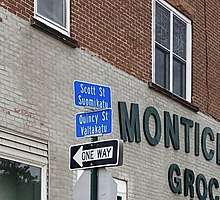
Hancock hosts an annual midwinter festival called Heikinpäivä in mid-January, celebrating the feast day of Saint Henrik of Uppsala, the patron saint of Finland, and Heikki Lunta. Heikinpäivä also includes a traditional Wife-carrying competition.[74][16][91] Every June, the cities of Hancock and neighboring Houghton host a festival known as Bridgefest to commemorate the building of the Portage Lake Lift Bridge, which united both the communities of Copper Island and those in the southern portions of the Keweenaw Peninsula.[16][91] Also held in June is the Keweenaw Chain Drive Festival.[91][92] The Keweenaw Trail Running Festival takes place each July.[91]
Demographics
| Historical population | |||
|---|---|---|---|
| Census | Pop. | %± | |
| 1880 | 1,783 | — | |
| 1890 | 1,772 | −0.6% | |
| 1900 | 4,050 | 128.6% | |
| 1910 | 8,981 | 121.8% | |
| 1920 | 7,527 | −16.2% | |
| 1930 | 5,795 | −23.0% | |
| 1940 | 5,554 | −4.2% | |
| 1950 | 5,223 | −6.0% | |
| 1960 | 5,022 | −3.8% | |
| 1970 | 4,820 | −4.0% | |
| 1980 | 5,122 | 6.3% | |
| 1990 | 4,547 | −11.2% | |
| 2000 | 4,323 | −4.9% | |
| 2010 | 4,634 | 7.2% | |
| Est. 2019 | 4,506 | [3] | −2.8% |
| U.S. Decennial Census[93] | |||
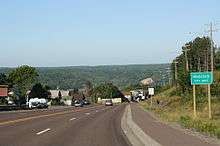
2010 census
As of the census[2] of 2010, there were 4,634 people, 1,882 households, and 934 families residing in the city. The population density was 1,782.3 inhabitants per square mile (688.1/km2). There were 2,111 housing units at an average density of 811.9 per square mile (313.5/km2). The racial makeup of the city was 94.7% White, 1.2% African American, 1.0% Native American, 1.7% Asian, 0.1% Pacific Islander, 0.1% from other races, and 1.3% from two or more races. Hispanic or Latino of any race were 1.4% of the population.
There were 1,882 households, of which 21.4% had children under the age of 18 living with them, 36.4% were married couples living together, 9.7% had a female householder with no husband present, 3.6% had a male householder with no wife present, and 50.4% were non-families. 37.7% of all households were made up of individuals, and 13% had someone living alone who was 65 years of age or older. The average household size was 2.20 and the average family size was 2.90.
The median age in the city was 34.1 years. 16.7% of residents were under the age of 18; 21.8% were between the ages of 18 and 24; 20.8% were from 25 to 44; 21.5% were from 45 to 64; and 19.3% were 65 years of age or older. The gender makeup of the city was 49.5% male and 50.5% female.
2000 census
As of the census[4] of 2000, there were 4,323 people, 1,769 households, and 902 families residing in the city. The population density was 1,727.5 inhabitants per square mile (667.0/km2). There were 1,983 housing units at an average density of 792.4 per square mile (305.9/km2). The racial makeup of the city was 96.0% White, 0.8% Black or African American, 0.9% Native American, 1.1% Asian, <0.1% Pacific Islander, 0.2% from other races, and 1.0% from two or more races. 0.8% of the population were Hispanic or Latino of any race. 32.2% were of Finnish, 14.4% German, 8.2% English, 5.3% Italian, and 5.2% French ancestry according to Census 2000. 94.4% spoke English and 4.4% Finnish as their first language.
There were 1,769 households, out of which 23.3% had children under the age of 18 living with them, 39.2% were married couples living together, 9.2% had a female householder with no husband present, and 49.0% were non-families. 38.8% of all households were made up of individuals, and 14.9% had someone living alone who was 65 years of age or older. The average household size was 2.22 and the average family size was 2.97.
In the city, the population was spread out, with 19.0% under the age of 18, 18.0% from 18 to 24, 22.6% from 25 to 44, 20.1% from 45 to 64, and 20.3% who were 65 years of age or older. The median age was 37 years. For every 100 females, there were 98.6 males. For every 100 females age 18 and over, there were 97.1 males.
The median income for a household in the city was $28,118, and the median income for a family was $36,625. Males had a median income of $27,090 versus $22,150 for females. The per capita income for the city was $16,669. About 6.9% of families and 14.4% of the population were below the poverty line, including 7.0% of those under age 18 and 15.1% of those age 65 or over.
Neighborhoods
The East Hancock neighborhood is part of the city and consists of many old Victorian-style houses which were once owned by mining company officials.
Doctors' Park is a neighbourhood located in West Hancock near the former Portage View Hospital Building (now the Jutila Centre of Finlandia University). It lies north of West Quincy Street.
The Quincy Street Historic District encompasses the center of Hancock's downtown, covering the 100, 200, and 300 blocks of Quincy Street.
UP Health system operates a Hospital with a Level 3 Trauma Center at 500 Campus Drive Hancock, MI 49930 called the UP Health System - Portage.
Sports
The 2004 Professional Walleye Trail Championship Tournament was held partly in the city.[16]
Parks and recreation
Bicycling
The Jack Stevens Rail Trail runs through the city of Hancock and continues on 14 miles north to Calumet on a now-abandoned Soo Line Railroad grade.[37][94]
Snowmobiling
The Keweenaw Trail or Trail 3 is the main snowmobiling route to and from Houghton and Hancock, it connects to other nearby trails including the North and South Freda Trails which lead toward Lake Superior, and the Stevens Trail which goes to Calumet.[37]
Education

Public education
Elementary-school students attend the Gordon Barkell Elementary School (formerly Hancock Elementary School), middle school students Hancock Middle School and high-school students Hancock Central High School. Hancock Central High and Hancock Middle School are now connected.
Higher education
Hancock is the home of Finlandia University (formerly Suomi College). Suomi College was founded in 1896 by the Finnish Evangelical Lutheran Church of America. In the 1880s large numbers of Finns immigrated to Hancock to labor in the copper and lumber industries. One immigrant, mission pastor J. K. Nikander of the Finnish Evangelical Lutheran Church of America, headquartered in Hancock, wanted to ensure seminary training in America. He had observed that Swedish and Finnish immigrants along the Delaware River did not train new ministers, and he feared a loss of Finnish identity. In 1896 Nikander founded Suomi College. The college's role was to preserve Finnish culture, train Lutheran ministers and teach English. During the 1920s Suomi became a liberal arts college. In 1958 the seminary separated from the college. Four years later the Finnish Evangelical Lutheran Church of America merged with other mainstream Lutheran churches. The cornerstone of Old Main, the first building erected at Suomi College, was laid on May 30, 1898. Jacobsville sandstone, quarried at the Portage Entry of the Keweenaw waterway, was brought here by barge, cut, and used to construct Old Main. Dedicated on January 21, 1900, it contained a dormitory, kitchen, laundry, classrooms, offices, library, chapel, and lounge. The burgeoning college quickly outgrew this building, and in 1901 a frame structure, housing a gym, meeting hall, and music center was erected on an adjacent lot. The frame building was demolished when Nikander Hall, named for Suomi's founder, J. K. Nikander, was constructed in 1939. The hall was designed by the architectural firm of Saarinen and Swanson, the former of which being the world-renowned Finnish-American architect Eero Saarinen.[95][96]
Several parts of the campus of Michigan Technological University are also located in Hancock, including a former MTU "underground classroom" in the Quincy Mine.[97]
Transportation
Highways



Intercity bus
Indian Trails bus lines operates a terminal at the Shottle Bop Party Store, 125 Quincy Street. The services runs between Hancock and Milwaukee, Wisconsin.[99] Until January 31, 2007 this was operated by Greyhound Bus Lines.
Public transportation
In the very late 19th and early 20th centuries, the Houghton County Traction Company ran a trolley system with service from Houghton, through Hancock, and on to other such destinations with the other boundaries being Hubbell to the northeast, and Mohawk to the far north.[12][16][42] The Mineral Range Railroad also historically served the city.[33][12]
Hancock Public Transit operates a demand bus which will take riders to anywhere in Hancock, Houghton, or Ripley. The service is headquartered on Quincy Street.[100][101][37] Checker Transport also provides service to the Hancock area from a satellite office in the region, though the main office is in Marquette.[102]
Notable people
Sister citiesHancock is the sister city of Porvoo, Finland. References
Sources
External links
|
